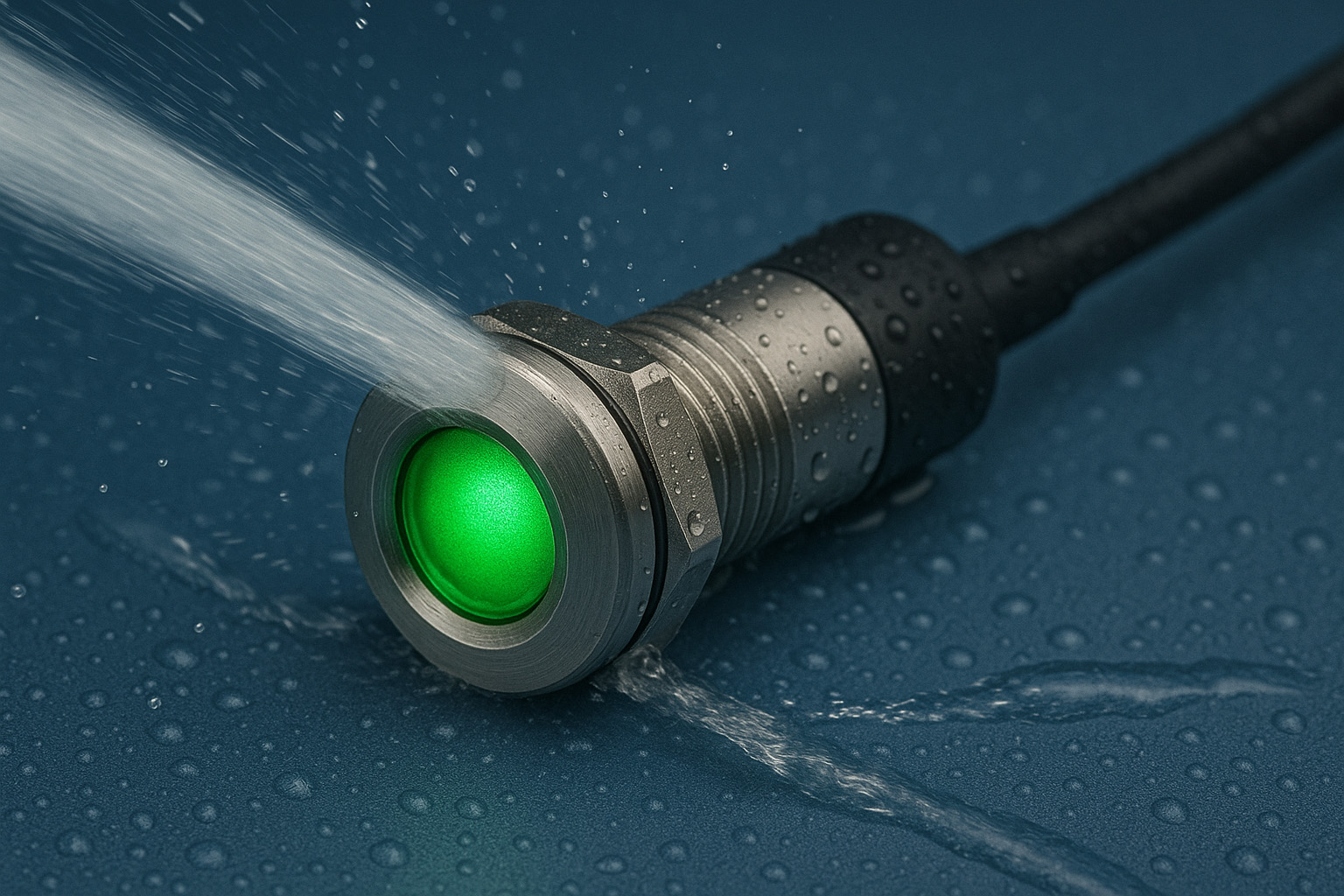
In the world of electronic design, components are often exposed to many environmental elements – from a dusty factory floor to an outdoor control panel in the rain, or even submerged marine equipment. For electronic indicators, which often provide critical visual feedback, ensuring adequate protection against solids and liquids is key. This is where IP (Ingress Protection) ratings come in, a globally recognized standard for defining a component’s level of environmental robustness.
What are IP Ratings?
IP ratings are defined by the international standard IEC 60529 and consist of the letters “IP” followed by two digits. These digits precisely quantify the degree of protection provided by an enclosure against the ingress of solid foreign objects (such as dust) and water.
First Digit (Solid Particle Protection)
This digit indicates the level of protection against the ingress of solid foreign objects, including human contact and dust. The scale ranges from 0 to 6:
0: No protection.
1: Protected against solid objects greater than 50 mm (e.g., accidental touch by hands).
2: Protected against solid objects greater than 12.5 mm (e.g., fingers or similar objects).
3: Protected against solid objects greater than 2.5 mm (e.g., tools, thick wires).
4: Protected against solid objects greater than 1 mm (e.g., most wires, small tools).
5: Dust protected (limited ingress of dust permitted, but not enough to interfere with the operation of the equipment).
6: Dust-tight (no ingress of dust; complete protection against contact).
Second Digit (Liquid Ingress Protection)
This digit specifies the level of protection against the ingress of various forms of moisture, from dripping water to high-pressure jets or continuous immersion. The scale ranges from 0 to 9K:
0: No protection.
1: Protected against vertically falling drops of water (e.g., condensation).
2: Protected against vertically dripping water when the enclosure is tilted up to 15°.
3: Protected against spraying water up to an angle of 60° from vertical.
4: Protected against splashing water from any direction.
5: Protected against water jets of low pressure (e.g., from a 6.3 mm nozzle) from any direction.
6: Protected against powerful water jets (e.g., from a 12.5 mm nozzle) from any direction.
7: Protected against immersion in water up to 1 meter for 30 minutes.
8: Protected against continuous immersion in water beyond 1 meter. The manufacturer must define the specific depth and duration.
9K: Protected against high-pressure, high-temperature jet sprays (e.g., steam cleaning or wash-downs).
Decoding Common IP Ratings
Understanding the individual digits allows you to decode standard IP ratings:
● IP65: This means the indicator is dust-tight (6) and protected against low-pressure water jets (5) from any direction. Suitable for general outdoor use, industrial control panels, or areas prone to splashes.
● IP66: Similar to IP65 but with enhanced water protection. It is dust-tight (6) and protected against powerful water jets (6). Ideal for applications that require more rigorous wash-downs or are exposed to heavy seas.
● IP67: This rating means the indicator is dust-tight (6) and protected against temporary immersion (7) in water up to 1 meter for 30 minutes. Found in marine equipment, outdoor lighting, or devices that might be briefly submerged.
● IP68: Represents superior protection, indicating that the device is dust-tight (6) and protected against continuous immersion (8) in water under conditions specified by the manufacturer (e.g., depths greater than 1 meter or for longer durations). Essential for submersible sensors, pool equipment, or devices exposed to constant wet conditions.

Application-Specific Examples:
● Outdoor Equipment (street lights, signage): Minimum IP65 or IP66 to withstand rain and dust.
● Marine & Nautical Applications (boat dashboards, navigation lights): IP67 or IP68 for protection against splashes, waves and temporary immersion.
● Industrial Washdown Areas (food processing, manufacturing plants): IP66 or IP69K to withstand high-pressure, high-temperature cleaning.
● Medical Devices (portable diagnostic equipment, cleanroom instrumentation): Often require IP65 or IP67 for protection against spills and easy cleaning.
VCC’s IP-Rated Solutions
At VCC, we recognize that environmental protection is a non-negotiable requirement for many applications. Our products feature a broad range of indicators and LEDs that meet demanding IP ratings. Our panel mount indicators and sealed LEDs are designed for harsh environments, with a focus on rugged construction and reliability.
VCC components go through testing procedures to ensure they meet their specified IP ratings, including dust chamber tests for solid particle ingress and various water immersion and jet tests. We guarantee our products will withstand the most challenging conditions.
Conclusion
Choosing the right IP-rated electronic indicators is not just a technical spec; it’s critical for product longevity, safety, and performance in harsh environments. By understanding the IP rating system and matching component specs to your application’s environmental challenges, designers can avoid costly failures, reduce maintenance, and build more reliable products for many industries.






